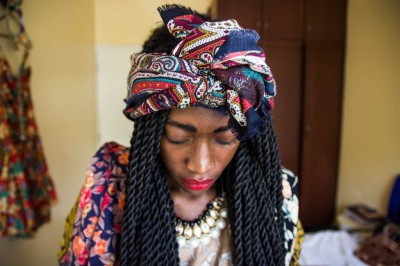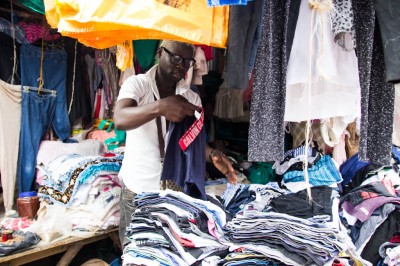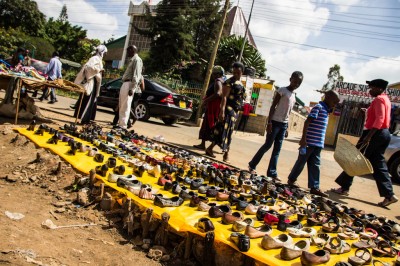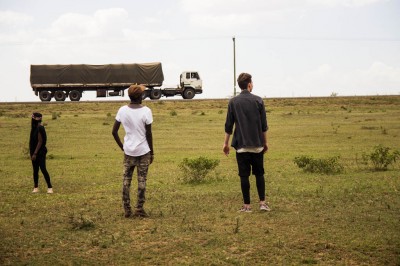As Seattle’s thrifting king so famously informs us, “one man’s trash, that’s another man’s come-up.”
Second-hand shopping is about more than just saving money these days. Rocking thrift-style clothing is a statement, a way of saying, “I am unique, and so are my clothes. And I bought these for a quarter the price of your new sweater.”
But to all of you Seattle thrift shoppers, let me tell you — if you think you’ve got it good, you have yet to scavenge through Nairobi, Kenya’s open-air markets.
Mtumbas (a Swahili word meaning ‘second-hand’) are modern day treasure troves jam-packed with chatty vendors who are ready to sell you everything from pots and pans to bedding to ‘boyfriend’ jackets (aka sport coats for women) to candlestick holders and even onions.
And aside from the bountiful produce, almost every item sold in the markets has been shipped from the West, often times the rejects of our own second-hand stores.
Every market is comprised of hundreds stalls made of tarpaulin, wood scraps, rusted doors and plastic — creating narrow, often muddy, alleyways customers must jump and trudge their way through in order to find buried treasure.
Vendors yell out their best prices as you walk by, waving shoes and sunglasses and hats in your general direction. Unless you’re fit to do some stubborn bargaining, be ready to pay twice the value of each item. But hey, it’s all a part of the experience.
The Neibaz Fashion House, consisting of Kevin Abraham (known as Abbra), Haji Mutonye, Ismael Akuku and Isiah Wakoli (not featured in photos), walk around downtown Nairobi sporting their latest looks. (Photos by Kelly Ranck — Click to enlarge)
Velma Rossa and Papa Petit, Nairobi natives and brother-sister stylists extraordinaire, have mastered the art that is scouring Nairobi’s mtumbas.
As professional stylists, the duo sources their apparel entirely from local second-hand markets.
“We spend most of our time shopping at Gikomba Market, East Africa’s largest thrift market, as well as Toi Market,” says Papa Petit.
Rossa and Papa display their unique mtumba findings on their tumblr, featuring photos of themselves sporting their apparel all over Kenya (I had the honor of photographing one of these shoots myself recently).
“In a city where many high-end labels are not sold in the malls, the market is the only place to find them,” explains Rossa. “With second hand, I find I get more options and unique styles that I don’t quite see in the malls — basically non-Chinese stuff.”
Velma Rossa of 2manysiblings featured in her home in Lavington. (Photos by Kelly Ranck)
But Velma Rossa and Papa are not the only people who’ve discovered the beauty that is Nairobi mtumba.
Twenty three-year-old Hellen Masido writes about her mtumba shopping experiences on a blog called StoryZetu.
“I gravitate towards aesthetically pleasing things which are unique and have high chances of not being seen on anyone other than me,” Masido explains. “My favorite part about shopping mtumba is the pleasant surprise of stumbling upon fabulous things you didn’t know you’d find.”
By blogging about her mtumba adventures, Hellen hopes to generate greater public awareness about maximizing one’s shopping trips.
“Previously, thrifting was seen as a necessity for those who were too broke. Of late, however, it is definitely is becoming a choice — and a cool one at that,” Madiso says. “I see most young people identifying with items that brand them, and this calls for a uniqueness in their style. Thrifting offers that.”
“Mtumba is absolutely sustainable for the people who depend on making clothes sales to earn a living. From the bale shippers, to the wholesaler to the vendor by the roadside,” says Papa Petit.
A sustainable, trendy, sub-culture. Sound familiar?
“More and more of the younger generation are looking for that unique look and for cheaper. And some of them have opened up their own stalls and deal with second hand clothing,” adds Velma.
Neibaz Fashion House — a collective of young Nariobi fashion lovers, takes mtumba shopping even one step further.
They’ve established a successful business focused on male lifestyle and fashion. The collaborative uses apparel purchased in Nairobi’s second hand markets to create editorials, marketing campaigns, advertisements, and trend analysis. Their work and fashion advice is quite popular among many a Nairobi gentleman.
Lemmy Lekoelea Aloo shops around and works at the Toi Market in Nairobi. (Photos by Kelly Ranck)
Then there’s Lemmy Lekoela, a man who prescribes to his own version of mtumba.
I first met Lekoela when shopping mtumba myself. Perusing Toi Market, I stumbled upon his vibrant stall — exploding with well-displayed skirts and dresses. With his bleached blonde hair and one-piece neon green outfit, Lemmy’s personal fashion was reason enough to examine the cornucopia pouring from his.
Living just minutes from Toi, Lemmy has shopped and worked in mtumba fashion for years. It is more than just a fashion lifestyle, it is also one of his sources of income.
“In Nairobi, city people love fashion and the best fashion can only be found in a second-hand market,” he shares. “Mtumba shopping feeds a lot mouths, is stylish, long lasting and genuine.”
If you’re starting to feel jealous, don’t worry. There are still some advantages to thrifting in Seattle, according to former Goodwill employee Makay Mohamad.
Originally from Somalia, she moved with her family to Seattle from Kakuma, one of Kenya’s largest refugee camps, just over 5 years ago.
“I worked at Seattle Goodwill from 2009 to 2014,” she says. “It was fun to sort clothes. I learned about brand name items that are more expensive than others.”
Interestingly, Mohamad says she shops second hand much more in the U.S. than she ever did in Kenya.
“In Kenya, I shopped in the market and got brand new clothes. I did not purchase used clothes because everything is mixed together — boys, girls, men, and women. It takes all day long to sort through the clothes and sometimes you walk away without anything,” she explains.
The founders of Neibaz Fashion House, on a shopping trip at the Toi Market. (Photos by Kelly Ranck)
“Everything is organized at the Seattle Goodwill: size, color, sections for women, men, boys, and girls. There are also color-coded discounts, so if you go back on Monday you can get a discount because of the color of the tag. Here I can buy quality items for my family at an affordable price,” she says.
These days, there’s an element of danger to second-hand shopping far more dangerous than poorly sorted wares or overly-aggressive hawkers. Last month the Gikomba second hand clothes market in Nairobi was hit with a bomb attack that killed 10 people.
But both the Neibaz boys and 2 many siblings said that the bombings won’t deter them for carrying on with their business in mtumbas.
“You know, there is a difference between fashion and style,” adds Akuku of Neibaz. “Fashion is what culture claims as cool or trendy. Style is what you create for yourself as cool. Mtumba is style.”
Velma Rossa and Papa Petit, of 2manysiblings, and friend Tim Borchert in Naivasha, Kenya. (Photos by Kelly Ranck and Joshua Obaga)














































Good job Kelly, God is using you in ways incredible!!!!
Keep doing what you are doing, it is beautiful. I have enjoyed reading your stories and looking at happy photographs of happy people.
Blessings and love,
Bren
Its a masterpiece an Art_Attack il say. Thankyou so much Kelly for the feature.
Its amazing that you have given platform to young trends and enthusiastic people to showcase what they do best and be able to make this viral. Great job. It ought to get those draconic minds to whats right.
Brilliant article and beautiful photographs, Kelly! I can’t wait to thrift it up in nairobi one day!
Awesome article and pics! Might borrow a few in future ;-) Going thrifting at Gikomba tomorrow. You totally got me in the mood!
I see my skirts guy place on the photos.
Father! Great man.
I recently checked out the fashion section of kilimall and realised they have really nice clothes with good offers as well